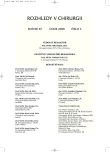Intra-aortic Balloon Counterpulsation in Cardiac Surgery Patients – Experiences of Department of Cardiac Surgery, Charles University, Faculty of Medicine in Hradec Králové, University Hospital Hradec Králové, Czech Republic
Authors:
V. Svitek; J. Manďák; J. Harrer
Authors‘ workplace:
Hradec Králové, prednosta: doc. MUDr. J. Harrer, CSc.
; Kardiochirurgická klinika Lékařské fakulty Univerzity Karlovy v Hradci Králové a Fakultní nemocnice
Published in:
Rozhl. Chir., 2008, roč. 87, č. 2, s. 68-73.
Category:
Monothematic special - Original
Overview
Aim:
To evaluate the use of intra-aortic balloon pump (IABP) at the Department of Cardiac Surgery, Charles University, Faculty of Medicine in Hradec Králové, University Hospital Hradec Králové and identifying the complications of this method and their frequency in long-term follow-up.
Method:
Retrospective analysis of the outcome of IABP use. From September 1994 to September 2007, 10,024 cardiosurgery operations were performed at the Department of Cardiac Surgery, University Hospital Hradec Králové, Czech Republic. IABP was applied in 363 cases (3.6%).Therapeutic indication for initiation of IABP at our department was the syndrome of low cardiac output in the postoperative period and during operation (difficulty in weaning from cardio-pulmonary bypass) and severe acute ischemic changes of myocardium refractory to pharmacotherapy. Prophylactic IABP was elective introduction of support before cardiac surgery in hemodynamically stable high risk patients.
Outcome:
From the group of 363 counterpulsated patients 192 were succesfully treated (52.9%), 171 patients (47.1%) died in consequence of cardiogenic shock and multiorgan failure. In 20 cases (5.5%) the IABP was introduced before the operation. Complications were observed in 61 patients (16.8%). Vascular complications were found in 27 cases (7.4%) including ischemic changes of the limb (14 cases – 3,9%), significant bleeding occurred at the site of puncture (7 cases – 1.9%), dissection of the femoral and iliac arteries (2 cases – 0.55%), perforation of the iliac artery (1 case – 0,3%). In 1 case (0.3%) the balloon was removed for intramural hematoma of the descending aorta without dissection. In 2 cases (0.55%) the balloon was led into the venous system. Thrombocytopenia occurred in our group in 23 patients (6.3%). Technical complications were observed in 7 cases (1.9%). None from our group of couterpulsated patinets had infectious complication.
Conclusion:
IABP is an effective and clinically verified mechanical cardiac support. Our results are similar to other studies.
Key words:
intra-aortic balloon counterpulsation – mechanical assist devices – cardiac surgery – syndrome of low cardiac output
Sources
1. Baskett, R. J. F., Ghali, W. A., et al. The Intraaortic Balloon Pump in Cardiac Surgery. Ann. Thorac. Surg., 2002, 74: 1276–1287.
2. Ferguson, J. J., Cohen, M., Freedman, R. J., et al. The current practice of intra-aortic balloon counterpulsation: results from the Benchmark registry. J. Am. Coll. Cardiol., 2001, 38/5: 1456–1462.
3. Arafa, O. E., Pedersen, T. H., Svennevig, J. L., et al. Vascular complications of the intraaortic balloon pump in patients undergoing open heart operations: 15-year experience. Ann. Thorac. Surg., 1999, 67: 645–651.
4. Kantrowitz, A., et al. Mechanical intraaortic cardiac assistance in cardiogenic shock. Arch. Surg., 1968, 97: 1000–1004.
5. Manďák, J., Lonský, V., Dominik, J., et al. Intraaortální kontrapulzace v léčbě srdečního selhání. Cor. Vasa, 2003, 45: 360–365.
6. Azeem, T., Stephen-Lloyd, A., Spyt, T., et al. Intra-aortic balloon counterpulsation: variations in use and complications. Int. J. Cardiol., 2004, 94: 255–259.
7. Davies, A. R., Bellomo, R., Saman, J. S., et al. High Lactate Predicts the Failure of Intraaortic Balloon Pumping After Cardiac Surgery. Ann. Thorac. Surg., 2001, 71: 1415–1420.
8. Meharwal, Z. S., Trehan, N. Vascular complications of intra-aortic balloon insertion in patients undergoing coronary revascularization: analysis of 911 cases. Eur. J. Cardiothorac. Surg., 2002, 21: 741–747.
9. Arceo, A., Urban, P., Dorsaz, P. A., et al. In-hospital complications of percutaneous intra-aortic balloon counterpulsation. Angiology, 2003, 54-5: 577–585.
10. Ramnarine, I. R., Grayson, A. D., Dihmis, W. C., et al. Timing of intra-aortic balloon pump support and 1-year survival. Eur. J. Cardiothorac. Surg., 2005, 27: 887–892.
11. Jafary, F. H., Khan, S. A., Kumar, H., et al. Survival of patients treated with intra-aortic balloon counterpulsation at a tertiary care center in Pakistan-patient characteristics and predictors of in-hospital mortality. BMC Cardiovascular Disorders [on line], 2004, 4:22. Dostupný z www.biomedcentral.com/1471-2281/4/22.
12. Manďák, J. Intaaortální balónková kontrapulzace. 1. vyd. Praha: Grada Publishing, 2006. 160 s. ISBN 80-247-0734-9.
13. Siegenthaler, M. P., Brehm, K., et al. The Impella Recover microaxial left ventricular assist device reduces mortality for postcardiotomy failure: A three-center experience. J. Thorac. Cardiovasc. Surg., 2004, 127, 3: 812–822.
14. Thiele, H., Sick, P., Boudriot, E., et al. Randomized comparison of intra-aortic balloon support with a percutaneous left ventricular assist device in patients with revascularized acute myocardial infarction complicated by cardiogenic shock. Eur. Heart J., 2005, 26: 1276–1283.
15. Cohen, M., Urban, P., Christenson, J. T., et al. Intra-aortic balloon counterpulsation in US and non-US centres: results of the Benchmark Registry. Eur. Heart J., 2003, 24: 1763–1770.
16. Trost, J. C, Hillis, L. D. Intra-aortic balloon counterpulsation. Am. J. Cardiol., 2006, 97–99: 1391–1398.
17. Manďák, J., Lonský, V., Dominik, J., Žáček, P. Vascular complications of the intra-aortic balloon counterpulsation. Angiology, 2005, 56, 1: 69–74.
18. Elahi, M. M., Chetty, G. K., et al. Complications related to intra-aortic balloon pump in cardiac surgery: a decade later. Eur. J. Vasc. Endovasc. Surg., 2005, 29–26: 591–594.
Labels
Surgery Orthopaedics Trauma surgeryArticle was published in
Perspectives in Surgery

2008 Issue 2
Most read in this issue
- „Tension Free“ Method in Inguinal Hernioplasty Using CHS 100 Mesh – Our Experience
- Benefits of Intraoperative N. Laryngeus Recurrens Neuromonitoring in Thyroid Surgery
- Spontaneous Rupture of Ductus Choledochus in Acute Pancreatitis – a Case Report
- Surgical Management of Proximal Humeral Fractures Using the Hackethal (Zifko) Method – A Case Review
